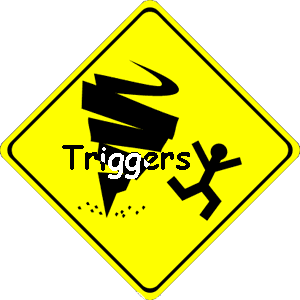
Quick Hits:
- Anxiety is our mind and body responding to perceived threat.
- Think of anxiety in three levels: green, yellow, and red – we want to stay out of the red zone where rational responses do not live.
- The main cause of anxiety is NOT YOU!
- Cognitive behavioral therapy (CBT) is the gold standard of anxiety treatments and works for more than 80% of people.
- It’s time to ask for help if relationships or productivity are being affected, or if someone is missing valuable life experiences as a result of their anxiety.
- See below for an anxiety FAQ list.
Parts of this post are written to the parent of an anxious child, however the information is consistent for adults with anxiety as well.
Does any of this sound familiar? Sweaty palms, heart racing, flushed skin, tantrums, black and white thinking, decisions we regret – these and so many more are common symptoms of anxiety.
Before we tackle the problem of anxiety I think it is helpful to define it. While anxiety can take many different shapes, I like to think of it like this:
Anxiety is our response to perceived threat.
We all perceive threats differently. What is threatening, or anxiety provoking, to someone else may not even register on your anxiety meter. One child may be terrified when being dropped off at school while another one can’t wait to get there. Regardless of the details of the perceived threat, we can all relate to feeling anxious at one time or another. Anxiety is a universally human experience.
It is the way we think about these perceived threats that determines how we deal with our anxiety. It can be helpful to think of your anxiety level in 3 zones – green, yellow, and red.
Green zone – you’re feeling good. Even if you are aware of a perceived threat, you feel in control and ready to handle it in a healthy way.
Yellow zone – you’re ok, but worried. You are aware of a perceived threat, but not sure you can deal with what is coming. This is the time to fall back and rely on your anxiety management skills.
Red zone – you are not feeling good. Your anxiety level has reached a point where rational thinking and using skills is no longer an option. Black and white thinking has taken over. From here we need to find a way to safely ride out the storm until we’re back in the yellow zone and we can use our skills.
The bad news: Anxiety is a tricky opponent. It affects different people in different ways. We don’t know everything there is to know about it yet, but we do know certain things.
The good news: One of the most important things we know is that the main cause of anxiety is NOT YOU! Let me say this again – you are not the cause of your child’s (or your own) anxiety. It is not your fault.
We do know that certain factors make it more likely for a child to experience issues dealing with anxiety. There are some genetic indicators, and there are some environmental indicators that studies show may increase a person’s likelihood of experiencing issues, but there is no reliably predictable cause. So, if you have been beating yourself up, thinking you caused the issues you are dealing with, you can stop that right now.
More good news: we know how to fix it! We have developed and studied a technique that is effective for over 80% of people dealing with issues related to anxiety! It’s called cognitive behavioral therapy (CBT). Basically, CBT helps us take control of our thoughts and feelings before we act in ways we regret. The basic idea is that thoughts lead to emotions and emotions lead to actions. We can practice and develop skills that allow us to interrupt our natural thoughts and/or emotions so they don’t lead us to actions that we regret.
Here’s an example. A child who has never practiced CBT skills may be anxious about being dropped off at school. They may have thoughts about being left alone, getting hurt, their parents getting hurt and not coming back to get them, or any other perceived threat. These thoughts lead to negative emotions like fear. Their body starts to react by increasing the heart-rate and responding to the perceived threat. Black and white thinking takes over. They are in the red zone and rational thought cannot occur. The action they take is to scream, cry, throw a tantrum, and do whatever it takes to protect themselves from the threat – at this point it’s essentially a fight, flight, or freeze response.
The same child, after practicing and developing CBT skills, is able to recognize when they are in the yellow zone. They recognize this feeling as a trigger to fall back on and use their skills. Their skills help them think about what is most likely to happen and that they are actually very safe at school. They even enjoy the time with their friends and teachers when they’re not in the red zone. Using their skills, they get themselves back to the green zone and do not behave in a way that they regret.
This is a very simple way of looking at CBT, but the principles are sound. CBT is the gold standard in behavior modification and anxiety spectrum issues. Medications can help, but many folks can realize wonderful results without them if they take the time to develop and practice their skills. And the best part is, the skills stay with us for a lifetime.
CBT focuses on realistic thinking skills to improve thoughts, awareness and relaxation skills to improve our emotional responses, and controlled exposure to triggering events to improve behaviors.
When should I reach out for help?
A licensed clinician can help you cultivate CBT skills in a matter of weeks. It is a great idea to reach out for help if you or your child:
- Have noticed a decrease in effectiveness, performance, or productivity at school or work as a result of anxiety
- Have noticed that your relationships are being negatively impacted by the symptoms and behaviors of anxiety
- Are missing out on meaningful life experiences as a result of anxiety.
There are more FAQs below, but I’d like to leave you with a quick summary.
It is very likely that you did not cause the anxiety that you or your child are experiencing. It is also very likely that you can “fix” it! You can learn and develop the skills to overcome the anxiety that is getting in the way of you living your fullest life. If you are frustrated with how things have been going, reach out to a licensed clinician and ask about a CBT plan. You can do this! I suspect you will find that the experience is less scary, less difficult, more effective and more common than you think. By practicing CBT skills, most children and adults alike come to know they are much braver and more capable than they think they are.
All the best to you as you make your progress,
Matt
Frequently Asked Questions about Anxiety:
How long does it take?
Of course the details vary, but most folks see progress in 4-6 weeks and consider their first round of work complete in 10-15 weeks. At that point, they are able to practice the skills they’ve learned in their day to day life. Some folks come back to their clinician for check-ups periodically or continue regular work when they uncover new behaviors they’d like to improve.
When is it fixed?
A person might consider the problem “fixed” when their symptoms decrease to a tolerable or non-existent level. However, the skills learned in CBT are meant to be used throughout our lives. If they are neglected and forgotten, the problems are likely to return.
What if my child is gifted?
There is some correlation between intellectual aptitude and anxiety issues. CBT is very effective with folks in these situations.
What if the child is resistant?
This is very common. Whether it’s the stigma associated with seeking help or the fact that talking about anxiety can increase a person’s anxiety – some folks are hesitant to working with a counselor. The truth is that no one can make progress without effort. So, they need to want to make improvements in order to do the necessary work to see results. However, there are techniques that help people stay in touch with their motivation and keep them coming back. Rewards and reinforcement can also be used at age-appropriate levels.
What about repetitive behaviors?
This is another sign that it is time to talk with a licensed clinician. Repetitive behaviors can be signs of other issues. They can also be improved by similar strategies – including building CBT skills and tapping into a person’s true motivation. The earlier one seeks treatment for these issues, the better.
What about siblings?
All of us are part of family systems to one degree or another. So none of our behaviors exist in isolation. Siblings can play a huge role in making symptoms better or worse. One of the many wonderful things about CBT skills is that they can benefit the entire family. If there is a dynamic with your child’s sibling(s) that is impacting their progress, you definitely want to bring that to the attention of your counselor.
How do I know what’s normal?
If you suspect that your child’s behavior may be outside of normal/typical range, you should seek the opinion of a licensed professional – this could be a counselor, pediatrician, or social worker. They will be able to help you decide what your next steps should be.
What do I do about test anxiety?
This is one of the most common triggers for anxiety in children. It also typically responds very well to treatment. Building CBT skills around reality checking, pre-test routines, and positive self-talk typically go a long way to relieving these symptoms.
Could it be manipulation instead of anxiety?
If, for example, throwing a tantrum gets the child what they want, then it is possible they have learned to manipulate their environment by using behaviors that are similar to those experiencing anxiety. It is important to be honest and consistent about the child’s behavior and your responses in order to know the truth about what is happening. A licensed clinician will be able to help you to know what to look for and what your next steps should be. Typically if the behavior becomes dangerous or is limiting their productivity or relationships, then it is more than manipulation. Either way, your clinician will be able to help you practice strategies for improvement.
To schedule an appointment with Matt, please call the office at (919) 382-0288 or Matt’s direct line is (919) 794-5490, or email at matt@bullcitypsychotherapy.com.














